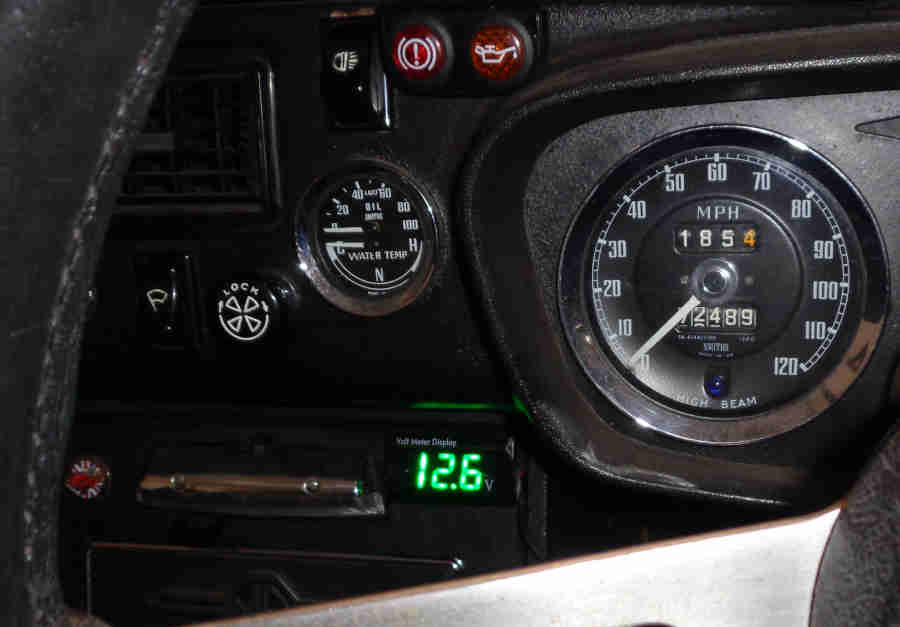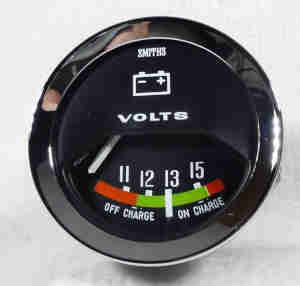 This classic voltmeter has a coloured scale which is useful for showing at a glance if the voltage is in or out of limits. Up to 15.2v is shown as 'green' and dynamo-equipped cars can show this although an alternator should not get that high. At the lower end above 11.5v is also shows as green, but for me anything below 12v may be discharging the battery - subject to voltage differences between where you have picked up the 12v supply and the battery cable on the solenoid.
This classic voltmeter has a coloured scale which is useful for showing at a glance if the voltage is in or out of limits. Up to 15.2v is shown as 'green' and dynamo-equipped cars can show this although an alternator should not get that high. At the lower end above 11.5v is also shows as green, but for me anything below 12v may be discharging the battery - subject to voltage differences between where you have picked up the 12v supply and the battery cable on the solenoid.
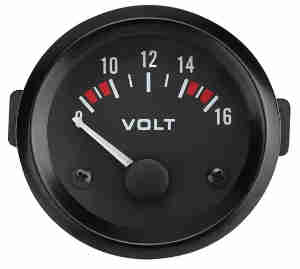 There are a few Smiths 'hanging pointer' (as above i.e. like the fuel gauge on pre-77 cars) volt meters around but they are very expensive being in the order of £50 plus. More common are 'upward pointer' types as here, they can be even more expensive from specialist shops but there are others in the £10-£15 range. This one has a less than ideal 10-14v 'good' range and a slightly compressed scale but can be lived with as I know what is good and what is bad! Interestingly these are described in some places as stepper-motor types that go up to the voltage quickly rather than slow-acting thermal like the fuel gauge on Mk2 cars. A sign of the times I suppose when components and assembly for that are cheaper than a bit of wire wrapped round a bi-metal strip! As well as 'pointing the wrong way' they only seem to be available with a black bezel, apart from some from India with a high P&P and a long lead-time. I was puzzled by a reference on one from Gorgeri to "When the white pointer stops running, remove the LED bulb from the rear and turn the white pointer a few times with a thin iron wire, then check." Analogue dials on up-market cars seem to wind round to max then back when you first turn on the ignition which I thought was just a gimmick. But it seems in some cases this is part of the calibration procedure as stepper motors can get out of ... well ... step and not show zero when off or the correct reading when on. I'm assuming these meters don't have that self-calibration feature so if they do get out of step one has to do it manually. We shall see, as I've ordered one!
There are a few Smiths 'hanging pointer' (as above i.e. like the fuel gauge on pre-77 cars) volt meters around but they are very expensive being in the order of £50 plus. More common are 'upward pointer' types as here, they can be even more expensive from specialist shops but there are others in the £10-£15 range. This one has a less than ideal 10-14v 'good' range and a slightly compressed scale but can be lived with as I know what is good and what is bad! Interestingly these are described in some places as stepper-motor types that go up to the voltage quickly rather than slow-acting thermal like the fuel gauge on Mk2 cars. A sign of the times I suppose when components and assembly for that are cheaper than a bit of wire wrapped round a bi-metal strip! As well as 'pointing the wrong way' they only seem to be available with a black bezel, apart from some from India with a high P&P and a long lead-time. I was puzzled by a reference on one from Gorgeri to "When the white pointer stops running, remove the LED bulb from the rear and turn the white pointer a few times with a thin iron wire, then check." Analogue dials on up-market cars seem to wind round to max then back when you first turn on the ignition which I thought was just a gimmick. But it seems in some cases this is part of the calibration procedure as stepper motors can get out of ... well ... step and not show zero when off or the correct reading when on. I'm assuming these meters don't have that self-calibration feature so if they do get out of step one has to do it manually. We shall see, as I've ordered one!
On arrival I did take the LED out but there was nothing to see except the back of the dial face, sticking an 'iron wire' in there could scratch the markings on the dial. There is a smaller hole lower down and initially I did think that would be for calibration but the other three applications (temp, oil pressure and fuel) have a third terminal there. Nothing about resetting on the instructions so that remains a bit of a mystery. It comes with additional plain and lockwashers and nuts for the terminals, you don't undo the ones shown here:
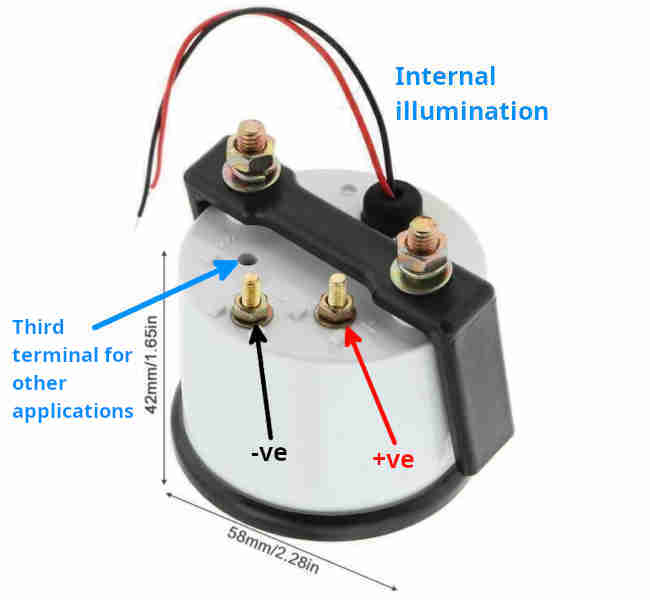
I tested the LED and the meter itself, the pointer rises quite rapidly on power application and falls similarly when power is removed. If it IS a stepper motor then the electronics must include a capacitor to hold enough charge to wind the needle back again when power is removed, and maybe that's why sometimes it can fail to completely wind back. The LED wires are very flimsy, I teed the earth connection with the earth supply for the meter into a through-hole connector on the case terminal to pick the earth up from the fuel gauge mounting bracket which is next to it. 12v is picked up from the fused ignition supply to the Smartscreen intermittent wiper control which is nearby, using a piggy-back spade connector.
Fortunately not too difficult to access where I will have mine on the V8 in a hole in the dash to the right of the fuel gauge (where the overdrive switch was on earlier cars) that a PO had cut for some ancillary gauge which I filled in although I was never happy with the result. Fitting was more of a fiddle than expected - I hope I don't have to remove it to reset the pointer! It uses a plastic U-bracket to secure it in the dash so I'm assuming that is why there are two studs on the case and holes in the bracket instead of just one. But that, together with the wires and in the restricted space behind the dash in that far corner, made it tricky to get the bracket onto both studs, and the plain washers, lock washers and nuts.
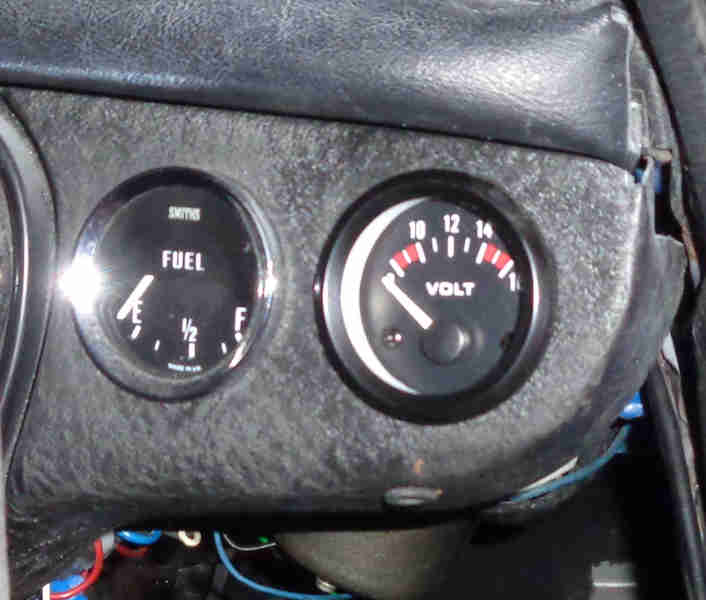
The instructions that came with the gauge show the LED connected to 12v and earth for all four applications (volts, fuel, temp and oil pressure) instead of the 12v coming from a dash illumination feed which means it will always be on with the ignition on. I've not connected that yet, it's very bright and I would need to add a resistor to tone it down to the level of the fuel gauge, and I rarely drive Vee at night:
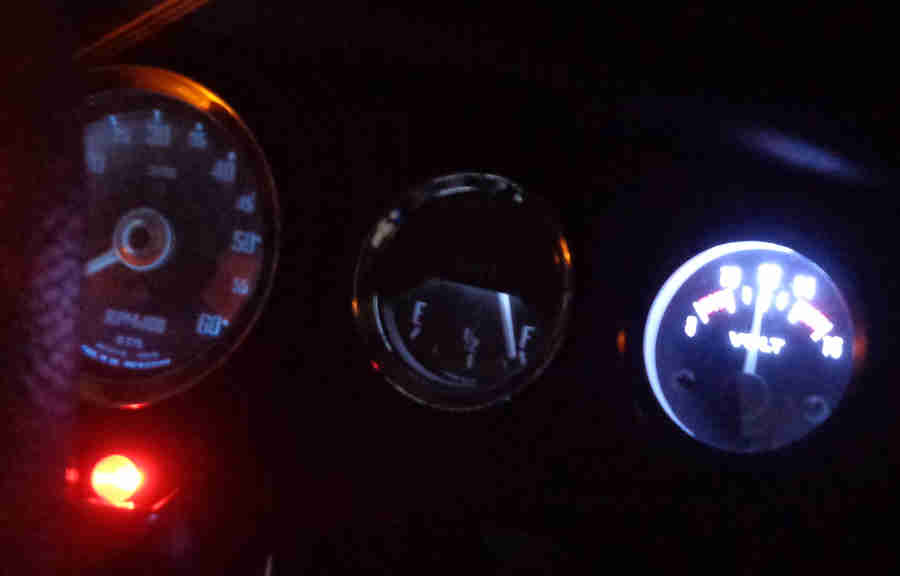
Testing it comes up to 12v with the ignition on, drops a volt or two when cranking, then goes up to 14v when charging. Ignition on and charging is as expected, but dropping when cranking is useful as it will show up a weak battery or weak connections from it to the starter solenoid, so in this case does indicate the 'strength' of the battery:
Not to be outdone (although the availability of this meter started it all off) Bee gets a digital:
